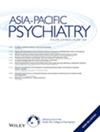An international medical education perspective on training in child and adolescent psychiatry
IF 3.4
3区 医学
Q2 PSYCHIATRY
引用次数: 1
Abstract
Martine Stecher Nielsen and colleagues' article ( 2021) in the Asia Pacific Psychiatry, which is the official journal of the Pacific Rim College of Psychiatrists and the Asian Federation of Psychiatric Associations, compared the status of child and adolescent psychiatry training programs and the workforce in child and adolescent mental health services in three geographical regions, namely South East Europe, the Middle East, and the Far East, to identify similar problems, highlight success stories, and to make recommendations for future regional studies. The study (Stecher-Nielsen et al., 2021) used data from the World Psychiatric Association, Child and Adolescent Psychiatry Section's regional projects including data from 44 countries. The study (Stecher-Nielsen et al., 2021) is extremely important, because it shows there is an urgent need for more qualified child and adolescent psychiatrists and allied professionals in a very large group of countries in South East Europe, the Middle East, and the Far East, with great differences in religion, culture, and economy. The aforementioned lack of qualified child and adolescent psychiatrists and allied professionals may result in various problems, which, in turn can lead to delayed identification, diagnosis, and treatment of child and adolescent mental disorders that can have lifelong consequences, due to the temporally regulated modifications brain undergoes during this neurodevelopmental period (Kieling et al., 2011). This (Skokauskas et al., 2019) is in line with the United Nations' Sustainable Development Goals (United Nations, 2015), adopted in 2015, which contributed to the greater recognition of both the current global mental health epidemic, and the urgent need for countries to allocate more resources. Martine Stecher Nielsen and colleagues (2021) in their article suggested, among other things that the future increase of the child and adolescent mental health workforce size, would inevitably mandate the implementation of other strategies such as advocating for child and adolescent psychiatry or child and adolescent mental health as a focus for both undergraduate and postgraduate trainees to ensure the long term expansion of training positions. This is very salient observation considering recent advances in genetics of childhood neurodevelopmental disorders, such as attention deficit hyperactivity disorder, autism spectrum disorder and intellectual disability (Parenti et al., 2020). Specifically, rare variants frequently affect protein function directly, providing a promising chance to discover the molecular mechanisms of neurodevelopmental disorders, such as autism spectrum disorder (Sanders et al., 2019). Various functional studies, using disease models such as induced pluripotent stem cells and genome-edited animals, with deleterious rare variants have been done to clarify the mechanism of pathogenesis and facilitate novel drug discovery. The aforementioned is conceptually in line with the Research Domain Criteria (RDoC) project (Insel, 2014), which aims to develop a research classification system for mental disorders, including child and adolescent psychiatric disorders, based upon dimensions of neurobiology and observable behavior. If such stimulating and promising hypotheses regarding molecular underpinnings of child and adolescent psychiatric disorders are offered as separate teaching modules during undergraduate and postgraduate medical training, we may expect that more students will develop interest in child and adolescent psychiatry. Furthermore, if child and adolescent mental health workers have the most recent information regarding the genetics of psychiatric disorders, and interactions between environmental and genetic factors, the implications regarding the course of mental disorder, and the risk to relatives, will almost certainly result in less stigmatization than with the beliefs that many people currently have about the origins of mental disorders. Martine Stecher Nielsen and colleagues ( 2021) also suggested the importance of taking into consideration the large Received: 3 February 2022 Accepted: 3 February 2022儿童和青少年精神病学培训的国际医学教育视角
本文章由计算机程序翻译,如有差异,请以英文原文为准。
求助全文
约1分钟内获得全文
求助全文
来源期刊

Asia‐Pacific Psychiatry
PSYCHIATRY-
CiteScore
7.80
自引率
0.00%
发文量
17
审稿时长
>12 weeks
期刊介绍:
Asia-Pacific Psychiatry is an international psychiatric journal focused on the Asia and Pacific Rim region, and is the official journal of the Pacific Rim College of Psychiatrics. Asia-Pacific Psychiatry enables psychiatric and other mental health professionals in the region to share their research, education programs and clinical experience with a larger international readership. The journal offers a venue for high quality research for and from the region in the face of minimal international publication availability for authors concerned with the region. This includes findings highlighting the diversity in psychiatric behaviour, treatment and outcome related to social, ethnic, cultural and economic differences of the region. The journal publishes peer-reviewed articles and reviews, as well as clinically and educationally focused papers on regional best practices. Images, videos, a young psychiatrist''s corner, meeting reports, a journal club and contextual commentaries differentiate this journal from existing main stream psychiatry journals that are focused on other regions, or nationally focused within countries of Asia and the Pacific Rim.
 求助内容:
求助内容: 应助结果提醒方式:
应助结果提醒方式:


